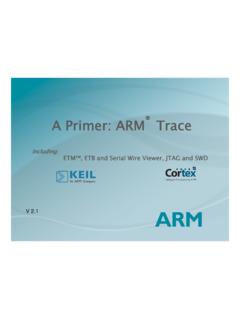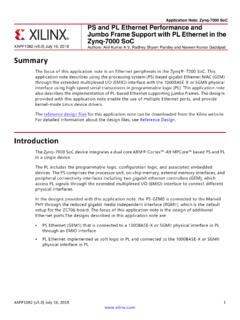Transcription of Hardware accelerated virtualization in the ARM Cortex ...
1 Sponsored by: & & Hardware accelerated virtualization in the ARM Cortex Processors John Goodacre Director, Program Management ARM Processor Division ARM Ltd. Cambridge UK 2nd November 2010 2 New Capabilities in the Cortex -A15 Full compatibility with the Cortex -A9 Supporting the ARMv7 architecture Addition of virtualization Extension (VE) Run multiple OS binary instances simultaneously Isolates multiple work environments and data Supporting Large Physical Addressing Extensions (LPAE) Ability to use up to 1TB of physical memory With AMBA 4 System Coherency (AMBA-ACE) Other cached devices can be coherent with processor Many core multiprocessor scalability Basis of concurrent Processing 3 Large Physical Addressing Cortex -A15 introduces 40-bit physical addressing Virtual memory (apps and OS)
2 Still has 32bit address space Offering up to 1 TB of physical address space Traditional 32bit ARM devices limited to 4GB What does this mean for ARM based systems? Reduced address-map congestion More applications at the same time Multiple resident virtualized operating systems Common global physical address in many-core 4 virtualization Extensions: The Basics New Non-secure level of privilege to hold Hypervisor Hyp mode New mechanisms avoid the need Hypervisor intervention for: Guest OS Interrupt masking bits Guest OS page table management Guest OS Device Drivers due to Hypervisor memory relocation Guest OS communication with the interrupt controller (GIC) New traps into Hyp mode for: ID register accesses and idling (WFI/WFE) Miscellaneous difficult System Control Register cases New mechanisms to improve.
3 Guest OS Load/Store emulation by the Hypervisor Emulation of trapped instructions through syndromes 5 How does ARM do virtualization Extensions to the v7-A architecture , available on the Cortex -A15 and Cortex -A7 CPUs Second stage of address translation (separate page tables) Functionality for virtualizing interrupts inside the Interrupt Controller Functionality for virtualizing all CPU features, including CP15 Option of a MMU within the system to help virtualize IO Hypervisor runs in new Hyp exception mode / privilege HVC (Hypervisor Call) instruction to enter Hyp mode Uses previously unused entry (0X14 offset) in vector table for hypervisor traps Hyp mode exception link register, SPSR, stack pointer Hypervisor Control Register (HCR) marks virtualized resources Hypervisor Syndrome Register (HSR) for Hyp mode entry reason 6 virtualization .
4 Third Privilege Guest OS same kernel/user privilege structure HYP mode higher privilege than OS kernel level VMM controls wide range of OS accesses Hardware maintains TZ security (4th privilege) User Mode (Non-privileged) Supervisor Mode (Privileged) Hyp Mode (More Privileged) Guest Operating System1 App2 App1 Guest Operating System2 App2 App1 Virtual Machine Monitor / Hypervisor 1 2 3 TrustZone Secure Monitor (Highest Privilege) Secure Apps Secure Operating System Non-secure State Secure State Exceptions Exception Returns 7 Memory the Classic Resource Before virtualisation the OS owns the memory Allocates areas of memory to the different applications Virtual Memory commonly used in rich operating systems Virtual address map of each application Physical Address Map Translations from translation table (owned by the OS) 8 Virtual Memory in Two Stages Stage 1 translation owned by each Guest OS Virtual address (VA) map of each App on each Guest OS Intermediate Physical address map of each Guest OS (IPA) Physical Address (PA)
5 Map Stage 2 translation owned by the VMM Hardware has 2-stage memory translation Tables from Guest OS translate VA to IPA Second set of tables from VMM translate IPA to PA Allows aborts to be routed to appropriate software layer 9 Classic Issue: Interrupts An Interrupt might need to be routed to one of: Current or different GuestOS Hypervisor OS/RTOS running in the secure TrustZone environment Basic model of the ARM virtualisation extensions: Physical interrupts are taken initially in the Hypervisor If the Interrupt should go to a GuestOS : Hypervisor maps a virtual interrupt for that GuestOS Operating System App2 App1 Guest OS 1 App2 App1 Guest OS 2 App2 App1 VMM System without virtualisation System with virtualisation Physical Interrupt Physical Interrupt Virtual Interrupt 10 Interrupt virtualization Virtualisation Extensions provides : Registers to hold the Virtual Interrupt CPSR.
6 {I,A,F} bits in the GuestOS only appling to that OS Physical Interrupts are not masked by the CPSR.{ } bits GuestOS changes to I,A,F no longer need to be trapped Mechanism to route all physical interrupts to Monitor Mode Already utilized in TrustZone technology based devices Virtual Interrupts are routed to the Non-secure IRQ/FIQ/Abort Guest OS manipulates a virtualized interrupt controller Actually available in the Cortex -A9 to aid paravirtualization support for interrupts 11 Virtual Interrupt Controller New Virtual GIC Interface has been Architected ISR of GuestOS interacts with the virtual controller Pending and Active interrupt lists for each GuestOS Interacts with the physical GIC in Hardware Creates Virtual Interrupts only when priority indicates it is necessary GuestOS ISRs therefore do not need calls for.
7 Determining interrupt to take [Read of the Interrupt Acknowledge] Marking the end of an interrupt [Sending EOI] Changing CPU Interrupt Priority Mask [Current Priority] 12 Virtual GIC GIC now has separate sets of internal registers: Physical registers and virtual registers Non-virtualized system and hypervisor access the physical registers Virtual machines access the virtual registers Guest OS functionality does not change when accessing the vGIC Virtual registers are remapped by hypervisor so that the Guest OS thinks it is accessing the physical registers GIC registers and functionality are identical Hypervisor can set IRQs as virtual in the HCR Interrupts are configured to generate a Hypervisor trap Hypervisor can deliver an interrupt to a CPU running a virtual process using register lists of interrupts 13 Virtual interrupt example External IRQ (configured as virtual by the hypervisor)
8 Arrives at the GIC GIC Distributor signals a Physical IRQ to the CPU CPU takes HYP trap, and Hypervisor reads the interrupt status from the Physical CPU Interface Hypervisor makes an entry in register list in the GIC GIC Distributor signals a Virtual IRQ to the CPU CPU takes an IRQ exception, and Guest OS running on the virtual machine reads the interrupt status from the Virtual CPU Interface Distributor Physical CPU Interface Virtual CPU Interface Virtual IRQ Physical IRQ CPU External Interrupt source Hypervisor Guest OS 14 Resource Ownership Software-only approaches Access to resources by GuestOS intercepted by the VMM VMM interprets the GuestOS s intent Provides its own mechanism to meet that intent Mechanism of interception varies Paravirtualisation adds a hypercall to the source code Binary translation adds a hypercall to the binary Exceptions in Hardware provide an trapping of operations Hypercalls can be more efficient More of the intent to be expressed in a single VMM entry Hardware assisted approaches.
9 Provide further indirection to resources Accelerating trapped operations by syndrome information 15 Helping with Virtual Devices ARM I/O handling uses memory mapped devices Reads and Writes to the Device registers have specific side-effects Creating Virtual Devices requires emulation: Typically reads/writes to devices have to trap to the VMM VMM interprets the operation and performs emulation Perfect virtualization means all possible devices loads/stores emulated Fetching and interpreting emulated load/store is performance intensive Syndrome information on aborts available for some loads/stores Syndrome unpacks key information about the instruction Source/Destination register, Size of data transfer, Size of the instruction, SignExtension etc If syndrome not available, then fetching of the instruction for emulation still required 16 Devices and Memory Providing address translation for devices is important Allows unmodified device drivers in the GuestOS If the device can access memory.
10 GuestOS will program it in IPA ARM virtualisation adds option for a System MMU Enables second stage memory translations in the system A System MMU could also provide stage 1 translations Allows devices to be programmed into guest s VA space System MMU natural fit for the processor ACP port ARM defining a common programming model Intent is for the system MMU to be Hardware managed using Distributed Virtual Messages found in AMBA 4 ACE 17 Potential of System MMU 18 Partitioning in a Secure ARM System ARM TrustZone technology define two worlds Everything must live in Normal World or Secure World TrustZone-Enhanced processor exports World Information Via NS bit (Not Secure) on system bus since AMBA 3 AXI TrustZone-Aware devices can partition across both worlds Only AMBA AXI compatible devices can be TrustZone-aware AMBA 3 AXI Interconnect decodes TZ like an address line AMBA AHB and APB do not contain TrustZone information AHB and APB devices live in only one World Groups of peripherals can be managed from bus interface Inclusion of TrustZone Peripheral Controller gives more control 19 Base Secure System Minimal TrustZone System required for payment solutions Protects On-Chip Secure Ram area via TrustZone Memory Adaptor Keyboard and screen secured dynamically to protect PIN entry Master Key and Random Number Generators for daughter-keys permanently secures.



